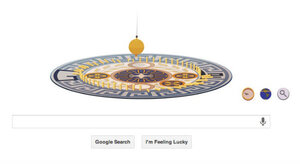Google doodle celebrates Léon Foucault's pendulum
Google doodle: Today's Google doodle celebrates French physicist Léon Foucault and his famous pendulum, which has become a symbol of the intersection of science, technology, engineering, art, and mathematics.

Google doodle: Today's Google doodle honors Jean Bernard Léon Foucault's pendulum.
Today the interactive Google doodle celebrates Jean Bernard Léon Foucault, a French physicist who in 1851 created the pendulum to prove the Earth’s rotation on its axis, but parents might prefer to thank him for being the big bang that probably led to the Spirograph and creative ways to get kids into STEAM education.
Sure, Foucault’s pendulum, as it came to be known, provided the first widely accepted proof of rotation using Earth-based, rather than astronomical, observations. However, like a hypnotist’s pocket watch the pendulum rapidly entranced artists and eventually our children in a hybrid world of Science, Technology, Engineering, Art, and Math we call STEAM.
“Foucault suspended a 67 meter, 28 kilogram pendulum from the dome of the Pantheon in Paris. The plane of its motion, with respect to the earth, rotated slowly clockwise. This motion is most easily explained if the earth turns,” according to the website for University of New South Wales, School of Physics, Sydney, Australia.
“Foucault was the original hipster of STEAM. He was doing science art before it was cool,” said Beau Turner, founder of MakerSpace757, one of many maker spaces around the country where inventors and innovators have access to a variety of tools and technology and can work in a hive mind environment, here in Norfolk, VA.
Okay, he might not have realized he was doing it, but Foucault was where the pendulum got into the swing of things. After the initial experiment many museums installed replicas of his design as art exhibits, infusing the science into the minds of artists worldwide and fueling their imaginations to wonder what the invisible patterns of the pendulum would look like if we could get them down on paper or sand or even in some cases in light.
I was at MakerSpace last night with my son for a bi-weekly Lego League team meeting and told Mr. Turner about the Foucault doodle. Makers are inventors, an eclectic group of technologists, math geeks, scientists, engineers, and dreamers of all ages.
Maker spaces are kind of like gym memberships for your brain. “Makers believe that if you can imagine it, you can make it. Everyone is a maker, and our world is what we make it,” Turner explained.
Families can join their local independently operated Maker space, a DIY environment filled with the physical tools they need to make their dreams into realities.
Foucault would have taken one look at the place and moved in lock, stock, and pendulum.
So while my son built his robot parts with the team, I sat down at a computer to research and “made” this blog.
A YouTube search for Foucault yielded a “sand pendulum” art video that helped me make the connection between Foucault’s Pendulum, Spirographs, and STEAM. The rest came from the Encyclopedia Britannica and various toy websites including Hasbro which now makes Spirograph.
STEAM powered art from Foucault to Spirograph goes something like this:
S: Science of astronomy was the catalyst so it deserves to be the first letter. Foucault decided to prove that the earth was spinning even though we can’t feel it doing so.
T: Technology is nothing more than, as Merriam-Webster puts it, “the use of science in industry, engineering, etc., to invent useful things or to solve problems.” The problem was that nobody believed the earth was spinning so Faucault invented a graceful and clever device to prove it was.
Foucault’s device would be modified over and over again evolving into the 1890s device called a harmonograph, a mechanical apparatus that usespendulums to create a geometric Spirography image, according to the Encyclopedia Britannica online.
E, A and M: British engineer Denys Fisher developed the Spirograph, a geometric art toy that draws mathematical curves known as hypotrochoids and epitrochoids. He reportedly based the toy on the invention by Bruno Abakanowicz who invented the integraph drawing device sometime between 1881 and 1900, all according to the Encyclopedia Britannica.
Fisher’s toy was first sold they year I was born in 1965. Today my nine-year-old’s favorite Kindle app is Geometric Pro which is like a living, touch-sensitive Spirograph for Dr. Who.
The Earth keeps spinning, new toys and gadgets are invented, but what really stands the test of time is our fascination with the art engaging our children in learning. Part of that we can trace back through the spiral of years to a man named Jean Bernard Léon Foucault.

